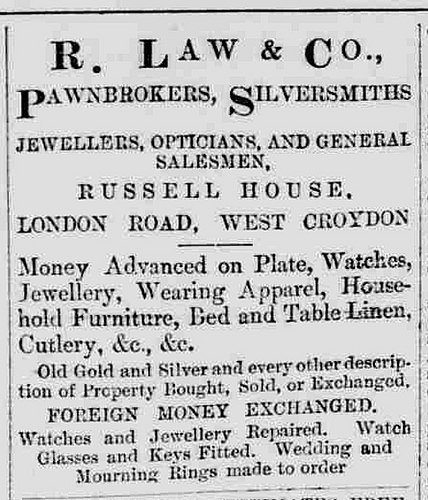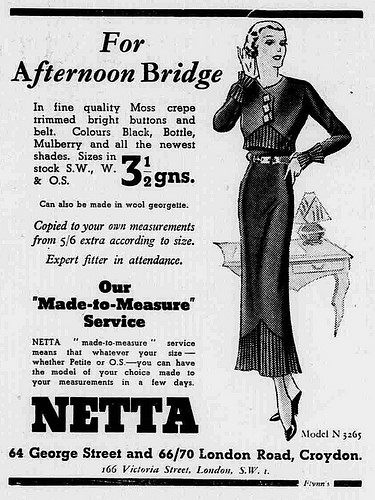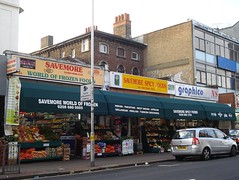Music shop Rockbottom is currently celebrating its 40th year on London Road. Originally opened at number 74 in 1975, it moved to larger premises at numbers 68–70 a decade later. It’s still going strong today, specialising in sales and repairs of guitars, drums, keyboards, and amplifiers, as well as offering studio space for rehearsals.
1860s–1870s: Construction of (at least one of) the buildings
The first impression when looking at these two shopfronts today is that they form a rather mismatched pair. Number 68 is tall — four storeys — while number 70 has only two storeys augmented by a decorative balustrade on top. However, looking closer reveals a couple of features in common. Protruding brickwork creates a vertical rectangular pattern running from the bottom of the first floor to the roof of both buildings. Moreover, although the sizes of the windows differ, the small panes and wreath-like decorations of number 70’s single first-floor window are echoed in the middle first-floor window of number 68.
So, is there a connection between the two buildings? Why do they look so different and yet still have these small similarities?
It should be remembered that construction along this part of London Road, between Oakfield Road and the General Hospital site, was all triggered by the death of Richard Sterry in February 1865 and the subsequent piecemeal selling-off of the Oakfield Estate. By October 1866, the land on which numbers 68 and 70 were later built was owned by a Mr Shearing, while the land to the south (later numbers 64–66) was owned by a Mr Wood, and the land to the north (later numbers 72–82) was up for auction in four lots.[1] It thus seems plausible that numbers 68 and 70 were built by the same person.

1870s–1900s: Law & Co, pawnbrokers
What is clear from the documentary evidence is that at least one of the present buildings was in place by the early 1870s, known as Russell House and occupied by Rosetta Law’s pawnbroking and jewellery business.[2] It’s possible that this was number 68 alone, and number 70 was built to join it as the business prospered.[3]
By 1881, Rosetta was employing at least four pawnbrokers’ assistants, including her nephew Robert,[4] who himself later took on a more prominent role in the business. By 1889, Kelly’s directories list “Robt. Law & Co” as the name of the business, and the 1901 census lists the 71-year-old Rosetta as “Living on own means” while Robert is a “Pawnbroker, Jeweller”. Rosetta did however retain her position as head of the household in this census, and when she died on 4 March of the next year, her estate was valued at £7,384 16s 8d (£811,000 in 2014 prices).[5]
In addition to pawnbroking, the Laws had been advertising themselves as opticians since at least 1884,[6] and by 1905, the business had branched out to also include dealing in musical instruments. It’s not clear whether these was were truly separate lines of business or simply specialisations of the existing pawnbrokery (i.e. the sale of second-hand spectacles and musical instruments provided by defaulters on loans). In any case, by 1911 Robert Law had left 68–70 London Road, and the premises fell vacant.[7]
1910s–1920s: Dennison & Co, ironmongers; Florence Nicholson, wool shop; Miss Nowne, ladies’ and children’s outfitter
Over the next couple of decades, numbers 68 and 70 took separate paths. Number 68 was occupied by Dennison & Co, ironmongers, from around 1913 to around 1929.[8] The twelve-paned front window of this shop was crammed with all kinds of items from saucepans to bird cages, and advertised “tools cutlery & electro plate” and “incandescent burners mantles & globes” as well as a knife and scissor sharpening service.[9]
Meanwhile, number 70 became home first to Florence Nicholson’s wool shop (which moved here from number 74 around 1912), and then to Miss Nowne’s ladies’ and children’s outfitter. Little information survives about either of these businesses, and both were gone by the early 1930s.[10]

1930s–1970s: Netta and F J Flynn
The properties were reunited after this relatively brief hiatus, as Miss A M Munt’s dress shop, originally situated at number 66, expanded first into number 68 and then into number 70. By this point the business was trading under the name “Netta”, and it was also associated with the clothing manufacturer F J Flynn. The expansion into number 68 was accompanied by the opening of another branch at 64 George Street.[11]
Netta clearly catered to the leisured classes, taking out newspaper advertisements showcasing made-to-measure dresses perfect for “Afternoon Bridge” and “gowns to grace the Royal Enclosure at Ascot”. One such gown, described as an “Intriguing little two-piece in floral ninon”, was priced at “the really wonderful price” of 49/6 in 1933 (£158 in 2014 prices).[12]
By the mid-1950s, the retail side of the business had been replaced by the manufacturing side, as Netta gave way to F J Flynn’s clothing factory. This remained until the mid-1970s, when it moved to 199 Brighton Road in South Croydon.[13]
1980s: Winn Dixie
F J Flynn’s replacement was Winn Dixie, a discount shop which is described more fully in my article on 64–66 London Road. This arrived in numbers 64–70 around 1979, but scaled back to 64–66 in the mid-1980s and finally closed for good a couple of years later.
1980s–present: Rockbottom
The next chapter in the life of 68–70 London Road actually began a decade earlier, in the mid-1970s, and a few doors along, at number 74. South Croydon resident Carl Nielsen, who originally trained as an electronics engineer, had been working at a music shop in central London since 1967, and decided it was now time to branch out on his own. An ex-girlfriend’s husband happened to own the lease on number 74, and so in 1974 Carl bought the lease and began renovating the building. He rented the upper floors to another company, and opened Rockbottom on the ground floor in 1975.[14]
By early 1985, Rockbottom had become successful enough to outgrow its premises, and so Carl moved his business a couple of doors down to the recently-vacated numbers 68–70, where it remains today. The business has seen some changes over the years, such as increased interest in microphones, tambourines, and PA systems from the gospel churches in the area. Although most of his custom now comes from people local to Croydon, Carl still gets phone calls from people looking for things within his specific areas of expertise — he’s well known for dealing in Marshall amps, for example.[15]
The business was hit badly by the riots of August 2011; along with fire damage to the building, Carl lost 400 guitars that night, some stolen, some simply smashed to pieces. Several months of closure and repair work followed, with Rockbottom finally reopening in April 2012. Carl is less than optimistic about the future, citing lack of footfall on London Road, the generally run-down nature of the area, and problems with crime including theft and drug gangs.[16] However, for now, Rockbottom remains one of the most widely-known and longer-standing businesses on London Road, and I for one hope it persists at least a little longer.
Thanks to: Brian Gittings; Carl Nielsen; Elissa Wild; Henry Braun; the British Newspaper Archive; the Planning Technical Support Team at Croydon Council; all at the Croydon Local Studies Library; and my beta-readers Flash, Kat, and Shuri. Census data consulted via Ancestry.co.uk. Monetary conversions performed using the Bank of England inflation calculator (prices < £100 given to the nearest penny, prices from £100 to < £100,000 to the nearest pound, prices from £100,000 to < £1 million to the nearest £1,000, prices from £1 million to < £100 million to the nearest £100,000, prices ≥ £100 million to the nearest million).
Footnotes and references
- See my article on 60–62 London Road for more information on Richard Sterry’s death and the Oakfield Estate sale. Evidence on land ownership as of October 1866 is taken from the sales particulars plan in the present article. Measuring on Google Maps satellite view confirms that these lots correspond to pairs of numbers today; numbers 60–62, 64–66, 68–70, and 72–74 are all around 36 feet wide, matching the distances marked on the 1866 map. (I am extrapolating slightly here, since the lots that had been sold to Messrs Stapleton, Wood, and Shearing have no widths marked, but it seems a fair assumption that they were the same widths as the others.) Interestingly, numbers 76–78 are wider, at around 42 feet, suggesting that Lots 2 and 3 were bought by the same person.
Wilkins’ 1872–3 directory lists R Law, pawnbroker, in between J E Hastings, pawnbroker, and J Rickett, Oakfield. J E Hastings was at numbers 60–62, and “Oakfield” was the remainder of the Oakfield Estate which later became the General Hospital site. This side of London Road had no street numbers until 1890, but R Law/Law & Co is listed consistently in the same place in street directories up to 1910, so following the numbering throughout the years makes it clear that it was in the buildings now numbered 68 and 70. Rosetta Law’s full first name is taken from the 1881 census. Ward’s directories from 1874 to 1885 inclusive use the name “Russell House”. Neither Rosetta Law nor Russell House appear in earlier street directories (the latest pre-1872 directory I have access to is Warren’s 1869). The 1871 census doesn’t list any occupants in between John Hastings (at the modern 60–62) and Oakfield Lodge.
It’s worth mentioning that when I interviewed Carl Nielsen at Rockbottom in May 2015, he told me about an engraving he’d found in one of the floors of the building while renovating it in the early 1990s, reading “Built 1850” or possibly “Built 1851”. However, I think this must be a red herring; before Richard Sterry died in 1865, this land was part of the Oakfield Estate, and not developed. It’s possible that the date was engraved by a later occupant of the building on the basis of inaccurate information.
It could however be the case that the building was constructed in the 1860s but remained unoccupied until the early 1870s. Later editions of Ward’s directories do list unoccupied buildings, but the earliest one I’ve so far found an “unoccupied” listing in is the 1874 edition.
- I originally wondered if number 70 was built first, on the cheap, and the taller number 68 was built later. However, Henry Braun points out (via email, 30 March 2015): “Doesn’t it look as though the taller building was there first? The shorter one’s parapet coping is brought to an end neatly, overlapping the party wall. [...] The first-floor windows of the taller building are a later, and ugly, insertion — compare their flat tops with the neatly fitting curved sashes upstairs. The middle window has been reglazed at the same time as the shorter building’s were put in, as they have matching decorative cartouches.” Looking closely at my March 2015 photo in the main article, I think Henry is correct here; that is, number 68 was built first, number 70 was built later (with brick edging mimicking that of number 68), and then the first floor of number 68 was reglazed to match the first-floor window of number 70.
- The 1881 census lists 52-year-old Rosetta Law as head of the household, with other inhabitants comprising Rosetta’s 48-year-old sister Louisa, 32-year-old nephew Robert (a pawnbrokers’ assistant), three other pawnbrokers’ assistants aged from 15 to 26, and two general servants.
- Rosetta’s date of death and value of estate are taken from her entry in the National Probate Calendar.
- See Surrey Mirror advertisement reproduced here; a very similarly-worded advertisement appears in the Surrey Mirror of 15 November 1884.
- Ward’s directories from 1905 to 1909 inclusive list R H Law & Co as pawnbrokers at the contemporary number 34 (modern number 68) and “Opt. and Mus. Inst. Dlrs.” at the contemporary number 36 (modern number 70), while the 1910 edition lists R H Law, jeweller and optician, at both numbers. The 1911 and 1912 editions list both properties as unoccupied.
- Ward’s directories list Dennison & Co from 1913 to 1929 inclusive.
- Details of shop window and quotations from signs taken from a c.1918 postcard image (reproduced in main article).
- Ward’s directories list Miss F Nicholson, The Wool Shop, in 1913, 1914, and 1915; “Unoccupied” in 1916; and Miss Nowne, ladies’ and children’s outfitter, from 1917 to 1930 inclusive. See my article on 74 London Road for more about Miss F Nicholson, including evidence on her first name.
- Ward’s directories list “Netta (A M Munt), Gown Specialist” at 66–68 in 1930 and at 66–70 in 1932; and “Netta, Costumier” at 66–68 in 1934 and at 68–70 in 1937 and 1939. A M Munt’s title of “Miss” is taken from Kelly’s 1927 directory, which lists her at number 66. Various advertisements for Netta in the Surrey Mirror in the 1930s (including the one reproduced above) have the notation “Flynn’s” in the small print; this must refer to F J Flynn Ltd, which took over numbers 66–70 from Netta. Ward’s directories list Netta at 64 George Street from 1930 onwards.
- The “Afternoon Bridge” dress advert appears on page 11 of the 2 November 1934 Surrey Mirror (reproduced above). The Ascot gowns advert appears on page 3 of the 26 May 1933 Surrey Mirror, viewed via the British Newspaper Archive (requires subscription).
- Kent’s 1955 and 1956 directories list F J Flynn Ltd, clothing manufacturers, at 66–70 London Road. F J Flynn is also listed at number 66 in Croydon phone directories up to and including 1973, and at 199 Brighton Road, South Croydon, thereafter. Note that the phone book listing at number 66 doesn’t imply that it was only at 66, as these phone books generally only list one street number even for shops spanning several addresses.
- All information in this paragraph provided by Carl Nielsen (in-person interview, 2 May 2015), aside from the date of 1967, which is taken from the history page on the Rockbottom website (Carl told me he’d been working at the other shop for “six or seven years” before buying the lease on number 74).
- Carl told me that Rockbottom moved from 74 to 68–70 in 1985 (in-person interview, 2 May 2015). The March 1985 Goad plan shows Rockbottom at numbers 68–70 and “Deccan rest closing down (Stuart Edwards)” at number 74. All other information in this paragraph also provided by Carl (same interview).
- All information provided by Carl Nielsen (in-person interview, 2 May 2015) aside from the fact of fire damage and the reopening date, which are taken from a Croydon Guardian article from 7 March 2012, another Croydon Guardian article from 8 August 2012, and an Eastlondonlines article from 2 August 2012.

